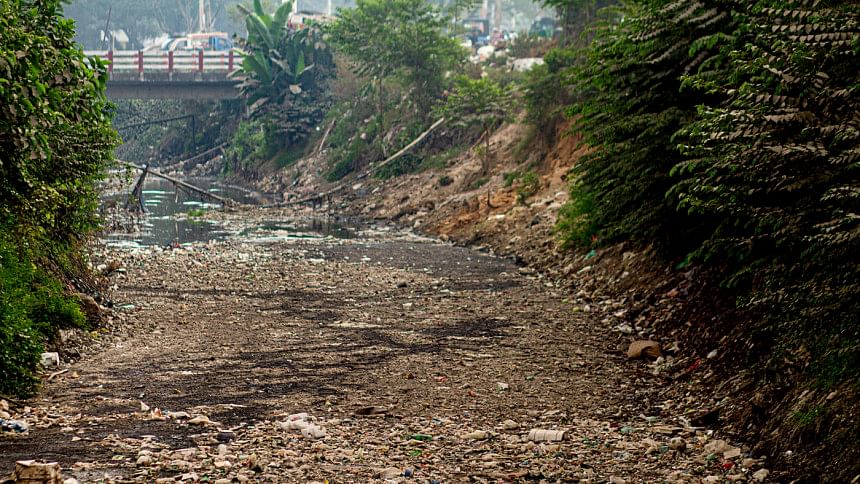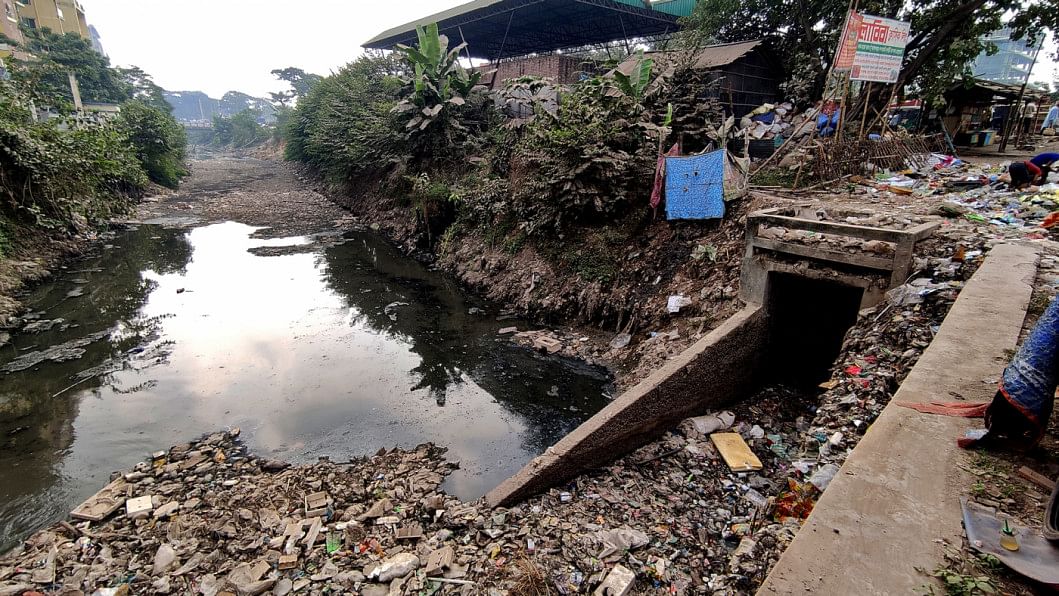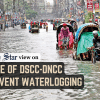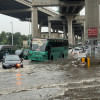Dhaka drowns every time it rains - here’s why

Once the lifelines of Dhaka, the city's canals are now mere shadows of their former selves—clogged with pollution, suffocated by encroachment, and neglected due to flawed urban planning. In this seven-part series, The Daily Star explores the current condition of the capital's canals, botched restoration attempts, and how the sorry state of these waterways is exacerbating the city's waterlogging woes. Together, these stories reveal what it will take to bring Dhaka's dying canals back to life. Here is the first part of the series:
In Dhaka, rain comes as a call for chaos. Streets get submerged, water often invades homes in low-lying areas, and life in the capital slows to a frustrating crawl.
The reason? Encroachments of canals, poor planning, and ignored solutions.
The capital's waterlogging crisis, which is the worst in 35 neighbourhoods, can largely be traced to the encroachment and narrowing of 11 crucial canals. These waterways, meant to drain the city, have instead been squeezed by unchecked urbanisation, becoming obstacles rather than lifelines.
A case in point is the 130mm rainfall on July 12, which inundated vast stretches of the capital. According to findings from the River and Delta Research Centre (RDRC), localities such as Pallabi, Shialbari, Rupnagar, and Eastern Housing face waterlogging due to significant narrowing of the Rupnagar Main Khal.
In Tolarbagh, Ahmednagar, and Paikpara, waterlogging stems from the complete encroachment of the Kalyanpur Main Khal behind Bangla College.

Similarly, Shewrapara, Kazipara, and Kafrul remain under water following rainfall as Ibrahimpur and Kalyanpur canals are now encroached on by 80 percent and 50 percent respectively.
Panthapath Box Culvert, largely blocked, causes frequent flooding in Kalabagan, Dhanmondi-27, Kathalbagan, Green Road, and Hatirpool. Meanwhile, the encroachment of Rayerbazar and Jirani canals -- around 80 percent of which are occupied -- leads to waterlogging in Hazaribagh, Nawabganj, Rayerbazar, West Dhanmondi, and Dhaka New Market.
Rampura and Badda endure waterlogging caused by the obstruction of natural water flow in Rampura Khal due to the Banasree Main Road.
Additionally, the low-lying areas from Banasree to Khilgaon Chowdhury Para have become reliant on inadequate storm drains after their natural drainage route through Banasree Canal was blocked.
Areas like Sutrapur, Wari, Nawabpur, Kazi Alauddin Road, Siddique Bazar, Narinda, and Tatibazar face waterlogging because the Dholai Khal, converted into a box culvert in 2007, is now 90 percent blocked.
Similarly, Jurain, Shyampur, and Rayerbagh grapple with the effects of the encroachment of Kadamtali and Manda canals, with Kadamtali 70 percent occupied and Manda clogged with garbage and polythene.
LOSS OF CANALS, POOR MAINTENANCE
A recent study by the River and Delta Research Centre (RDRC) revealed that canals and river channels in Dhaka once covered 565 hectares of land, according to the cadastral survey.
However, 55 percent of this area has now disappeared. Of the 307 hectares lost, 33.75 percent has been taken over by various structures, 18.92 percent by farmland, and 16.94 percent by streets. The remainder has either been filled in or turned into stagnant wetlands, the report stated.
Although Dhaka's two city corporations took charge of the drainage network, including canals, four years ago, experts argue that their failure to prepare a master plan has hampered progress.
Instead, the city corporations have installed drains on an ad-hoc basis, that have proven insufficient.
Besides, the 2016 Dhaka Drainage Master Plan prepared by Wasa has also been ignored.
The master plan had identified key issues such as: siltation and blockages in canals and drains, poor waste management, encroachment of flood plains and low-lying areas, indiscriminate land development, defective drainage structures and inadequate pumping and drainage facilities.
Despite two Dhaka city corporations spending Tk 262 crore over four years to install a combined 334.19km of drainage infrastructure, including box culverts and drains, the capital continues to face severe flooding during rains.
SOLID WASTE WORSENS DRAINAGE ISSUES
Poor solid and liquid waste management further aggravates the drainage crisis.
Dhaka city corporations said they collect only 85–90 percent of the city's waste, with the remainder often ending up in waterbodies and drains, causing blockages.
Moreover, Iqbal Habib, vice president of Bangladesh Poribesh Andolon (BAPA), emphasised the urgent need to address polythene usage, describing it as a "disaster" for drainage systems.
Furthermore, untreated sewage, which pollutes canals and waterbodies, creates conditions ripe for further encroachment.
Meanwhile, Dhaka Wasa was supposed to construct five treatment plants to manage sewerage under its master plan but has completed only one, in Dasher Kandi, so far.
CONCRETE JUNGLE, INCREASED RUNOFF
Rainwater percolation into the soil has drastically fallen in Dhaka due to urban sprawl.
The city, now dominated by concrete, sees 80 percent of rainwater flowing directly onto roads, overloading the drainage network.
In 1995, waterbodies made up 20.57 percent of Dhaka's central area, but by 2023, this figure had shrunk to just 2.9 percent, according to the Bangladesh Institute of Planners.
Green spaces have also diminished from 22 percent to 9 percent in the same period.
Dr Akter Mahmud, a member of the Bangladesh Institute of Planners' advisory council, stressed the importance of harvesting rainwater in public and private buildings in line with the Bangladesh National Building Code.
However, compliance with this requirement remains low.
ELEVATED ROADS: ANOTHER OBSTACLE
The indiscriminate elevation of roads over the years has exacerbated the waterlogging problem.
Dhaka's roads have been raised by over four feet in the last 15 years, rendering the levels of storm drains higher than those of houses and low-lying grounds, hindering water flow.
THE WAY FORWARD
To mitigate Dhaka's waterlogging, experts like Iqbal and Akter recommend the following: recovering and protecting canals, enhancing waste management, improving solid and liquid waste collection, enforcing strict policies against polythene use, rainwater harvesting and implementing the 2016 drainage master plan.
Without urgent intervention, Dhaka's waterlogging woes will only worsen, leaving its residents grappling with the aftermath of every downpour, experts added.

 For all latest news, follow The Daily Star's Google News channel.
For all latest news, follow The Daily Star's Google News channel. 








Comments